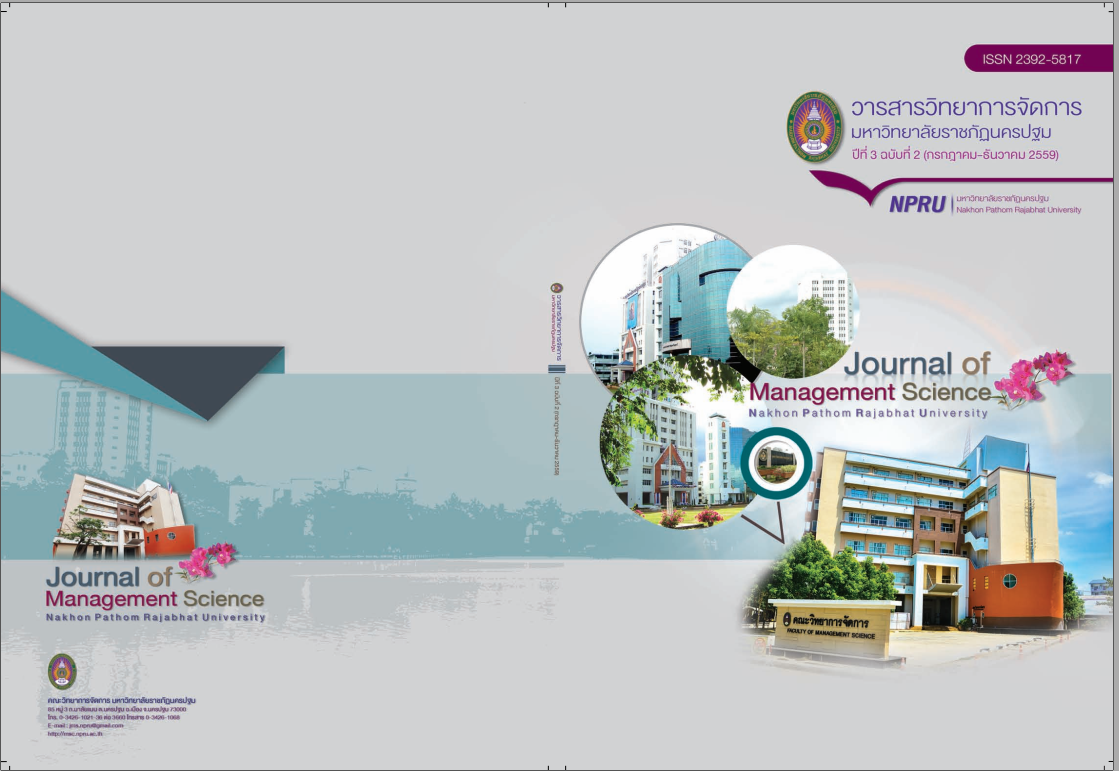Illegal Labor Migrants Management complying with Government’s Policy in Samut Sakhon Province.
Main Article Content
Abstract
This research aims to study “Illegal Labor migrants Management complying with The Thai government Policies in Samut Sakhon Province” The objectives of which are ; to investigate the problem of the management of illegal labor migrants management complying with the Thai government policies in Samut Sakhon province, to study the on-going implementation of the government’s policies regarding illegal labor migrants in Samut Sakhon province, and to study about problems and barriers affecting the management of illegal labor migrants management complying with the Thai government policies in Samut Sakhon province.
A critical realism paradigm and qualitative method were employed. In-depth interviews were conducted with various experts working for either government or private sectors using a semi-structured interview guide. Government officers interviewees were those who worked for Department of Employment, Office of Foreign Welfare Administrative, Immigration Bureau, Provincial Police Office, Department of Labor Protection and Welfare, Ministry of Social Development and Human Security, together with interviewees from products industrial companies, fisheries companies. The data was analyzed systematically and theoretically which largely inductive and interpretative. The research findings indicate that
1. The management of illegal labor migrants management was to grant and legalize them, to provide them wages and other employment conditions and benefits as well as to grant them all legal documentations, to allow their family members to follow them and to launch the new measurement importing new legal labor migrants to suit the appropriate actual numbers of provincial labor market’s need.
2. The Implementation of pre-determined policies in the context of Samut Sakhon province by arresting those who illegally acted against the laws and at the same time applying the amnesty processes was synchronizing completed. But, the cooperation from employers’ registering their migrant employees was still limited in number.
3. Problems and barriers affecting the management of illegal labor migrants management complying with the Thai government policies in Samut Sakhon province were; The policies were not clearly stated enough to be implemented effectively. Yet, too many details and conditions to be considered unavoidably. Furthermore, the Thai government did not strongly and fully support in many aspects, especially information needed that employers were not assured to follow those policies. Besides, the perceptions of the front-line officers were poor regarding to the existing of human trafficking in the area. Lastly, decision making, further planning and policies implementation evaluating were poor due to inadequate budget, information technological support system which affecting the controlling and problem solving effectively.
These research findings suggest that the policies implementation will be more successful with effectiveness and better concrete result in the future if the management of illegal labor migrants in Samut Sakhon province has more specific direction and appropriate policies implementation in comply with the Thai government’s policies. The management should monitor labor registering processes closely, collaborating with other functions concerned for more information and the sharing of necessary resources especially budget, tools and equipment. Finally, the management has to make sure that what they are doing is known to all people in the area.
Article history : Accepted 22 July 2016
SIMILARITY INDEX = 1.55
Article Details
The views and opinions of the article appearing in this journal are those of the author. It is not considered a view and responsibility of the editorial staff.
References
ข้อมูลจังหวัดสาคร. (2558). ประเภทของโรงงานอุตสาหกรรมที่ขออนุญาตประกอบการ. [ออนไลน์]. ค้นเมื่อ 16 กุมภาพันธ์ 2558. จาก https://www.samutsakhon.go.th/.
ปัญญาสยาม. (2556). จังหวัดที่มีคนต่างด้าวได้รับอนุญาตทำงานมาก 5 ลำดับแรก. [ออนไลน์]. ค้นเมื่อ 3 เมษายน 2558. จาก https://siamintelligence.com/thai-labor-migration-status/.
มยุรี อนุมานราชธน. (2547). นโยบายสาธารณะ แนวคิด กระบวนการและการวิเคราะห์. เชียงใหม่ : คนึงนิจการพิมพ์.
วรสุดา สุขรมณ์. (2554). ความร่วมมือระหว่างองค์การในการพัฒนาอุตสาหกรรมการท่องเที่ยวของไทย. วิทยานิพนธ์ปรัชญาดุษฎีบัณฑิต. สาขารัฐประศาสนศาสตร์. มหาวิทยาลัยรามคำแหง.
อุทัย เลาหวิเชียร. (2543). รัฐประศาสนศาสตร์ ลักษณะวิชาและมิติต่าง ๆ (พิมพ์ครั้งที่ 6). กรุงเทพมหานคร : สำนักพิมพ์เสมาธรรม.
Agranoff, R. (2006). Isside collaborative network : Ten lessons for public managers. Public Administration Review, 61(63). 57-59.
Agranoff, R., & McGuire, M. (2003). Collaborative public management : New strategies for local governments. Washington, D.C.: Georgetown University Press.
McGuire, M. (2006). Collaborative public management : Assessing what we know and how we know it. Public Administration Review, 66(4), 33-43.
World Economic Forum. (2010). The global competitiveness report 2010-2011. Geneva, Switzerland : Author.


